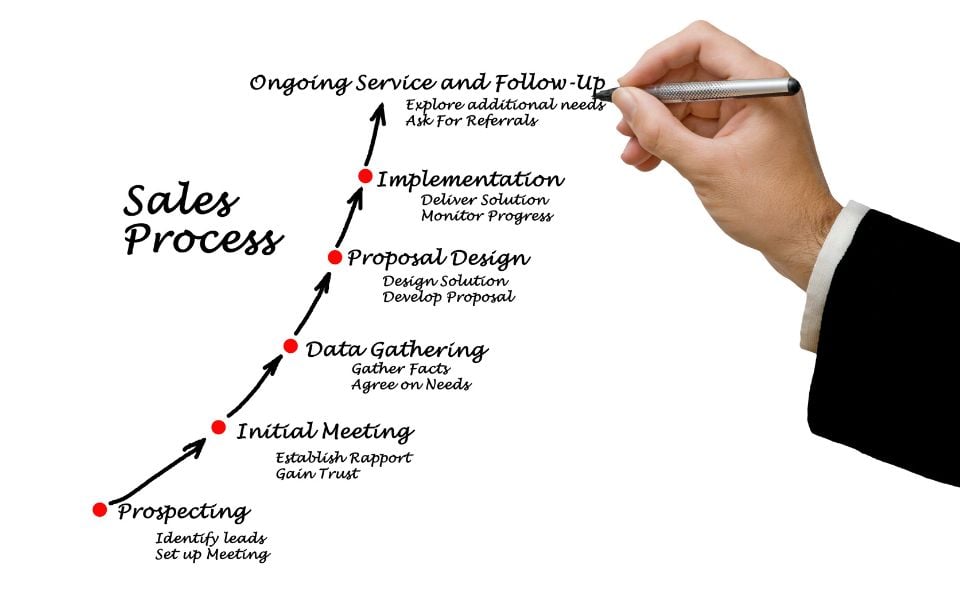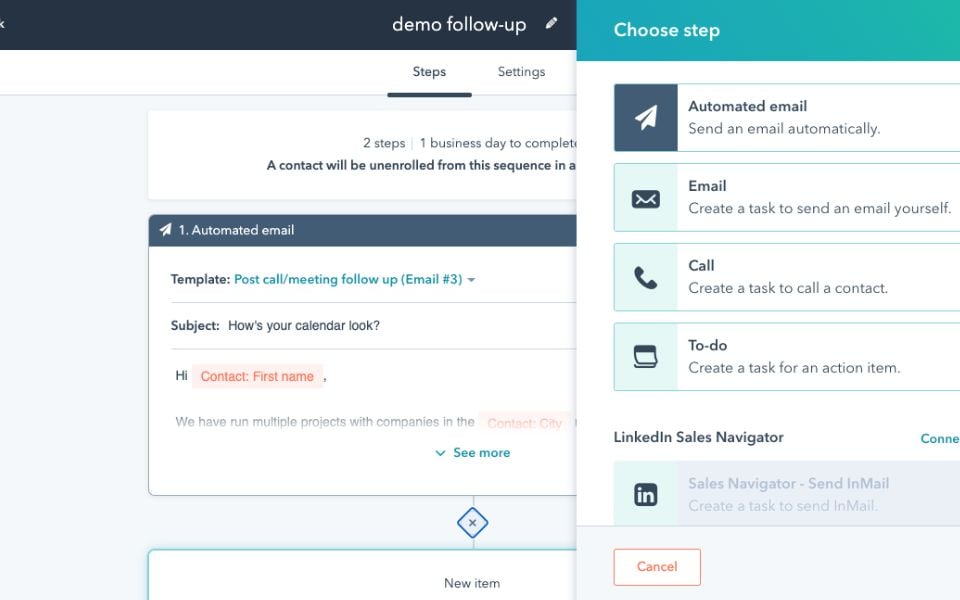Tips for Successfully Nurturing Leads with Sales Automation
Are you struggling to find enough time to nurture all of your leads? Are you looking for ways to improve your sales and lead generation efforts? If so, you're not alone. Many marketers, sales managers, and business owners face similar challenges, especially in today's fast-paced business world.
But don't worry, there's a solution! By using sales automation, you can effectively nurture a lead and drive sales without breaking a sweat. In this article, we'll show you how to successfully nurture leads with sales automation, including tips for creating an effective lead nurture strategy, crafting nurture emails and messages, measuring the success of your efforts, and integrating lead nurturing into your overall sales process.
But before we dive in, let's start with the basics: what is lead nurturing, and why is it so important? Simply put, lead nurturing is the process of building and maintaining relationships with potential customers over time, with the goal of eventually turning them into paying customers. Think of it as a way to provide ongoing support and guidance to your leads as they move down the sales funnel.
And with the help of sales automation tools like HubSpot Sales, you can streamline and optimise your lead nurturing efforts, freeing up time and resources to focus on other areas of your business. So if you're ready to learn more about how to nurture your leads and drive sales with automation, keep reading!
What is Lead Nurturing?

Lead nurturing is all about building and maintaining relationships with potential customers. It's a way to provide ongoing support and guidance to leads as they move down the sales funnel, helping them to better understand your products or services and how they can benefit from them.
But it's important to note that lead nurturing is not the same as lead generation. Lead generation refers to the process of attracting and capturing the interest of potential customers, while lead nurturing is focused on supporting and guiding those leads through the sales funnel.
The difference between lead nurturing and lead generation
Think of it this way: lead generation is like planting seeds, while lead nurturing is like providing the necessary water and sunlight to help those seeds grow into healthy plants. With the right nurturing, your leads will be more likely to convert into paying customers.
And with the help of sales automation tools, you can easily nurture your leads and improve your chances of success. In the next section, we'll explore the many benefits of lead nurturing and how sales automation can help.
The Benefits of Lead Nurturing
Increased sales and revenue
Lead nurturing is a powerful tool for increasing sales and revenue for your business. By providing ongoing support and guidance to leads as they move through the sales funnel, you can improve your chances of making a sale. Think of it as a way to water and fertilise your leads, helping them grow into paying customers.
Lead nurturing can also help you convert more leads into paying customers, resulting in increased sales and revenue for your company. By answering questions and addressing any concerns, you can build trust and credibility with your leads, increasing the likelihood that they will make a purchase.
Improved customer relationships and loyalty
In addition to driving sales and revenue, lead nurturing can also improve customer relationships and loyalty. By consistently providing value and answering questions, you can build trust and credibility with your leads, leading to long-term customer relationships.
Think of it as a way to provide ongoing support and guidance to your leads, helping them to better understand your products or services and how they can benefit from them. By nurturing your leads and building strong relationships, you can increase customer loyalty and drive repeat business.
Higher conversion rates

Lead nurturing can also lead to higher conversion rates. By staying top of mind with your leads and addressing any questions or concerns they may have, you can increase the likelihood that they will make a purchase.
Think of it as a way to provide ongoing support and guidance to your leads, helping them to better understand your products or services and how they can benefit from them. By nurturing your leads and addressing any objections or concerns, you can increase the likelihood that they will convert into paying customers.
In short, lead nurturing is a powerful tool for driving sales and revenue, improving customer relationships, and increasing conversion rates. And with the help of sales automation, you can easily and efficiently nurture your leads, reaping the many benefits of a successful lead nurture program.
The Role of Sales Automation in Lead Nurturing
Sales automation is a powerful tool for streamlining and optimising your lead nurturing efforts. With the help of automation, you can easily and efficiently nurture your leads, freeing up time and resources to focus on other areas of your business.
Think of sales automation as a gardener tending to a garden. Just as a gardener uses tools and techniques to efficiently care for and nurture plants, sales automation helps you efficiently nurture and manage your leads.
Examples of how HubSpot Sales automates lead nurturing tasks
There are many ways that sales automation tools, like HubSpot Sales, can help automate lead nurturing tasks. Some examples include:
- Scheduling and sending nurture emails and messages: Automation tools can help you schedule and send nurture emails and messages to your leads on a consistent basis. This can help you stay top of mind with your leads and provide them with valuable information and support.
- Tracking lead activity: Automation tools can help you track lead activity, such as website visits and email opens. This can help you better understand your leads and their interests, allowing you to tailor your nurture efforts accordingly.
- Qualifying leads: Automation tools can also help you qualify leads, identifying which leads are most likely to convert into paying customers. This can help you prioritise your lead nurture efforts and focus on the leads that are most likely to result in a sale.
As you can see, sales automation can be a valuable tool for automating lead nurturing tasks and improving the efficiency and effectiveness of your lead nurture program. In the next section, we'll discuss how to create a lead nurture strategy to make the most of your automation efforts.
Creating a Lead Nurturing Strategy

Creating a lead nurturing strategy is an important step for any business looking to effectively nurture leads and drive sales. Just as a blueprint is a crucial tool for building a successful garden, a lead nurturing strategy is a crucial tool for building a successful lead nurture program.
A lead nurture strategy helps you map out the specific steps you will take to nurture your leads and move them through the sales funnel. It helps you identify your target audience, create relevant and valuable nurture content, and track the success of your efforts.
Steps for creating a lead nurturing strategy
So, how do you create a lead nurturing strategy? Follow these steps:
- Identify your target audience: Who are you trying to reach with your lead nurture efforts? It's important to understand your target audience and their specific needs and pain points.
- Determine your goals: What do you hope to achieve with your lead nurture program? Are you looking to increase sales, improve customer relationships, or both? Clearly defining your goals will help you create a more targeted and effective lead nurture strategy.
- Create a content plan: What types of content will you use to nurture your leads? Will you use emails, social media posts, blog articles, or a combination of these? Create a plan for creating and distributing nurture content that aligns with your goals and target audience.
- Set up tracking and measurement: How will you track the success of your lead nurture efforts? It's important to establish key metrics and set up tracking to measure the effectiveness of your lead nurture program.
- Make adjustments as needed: As you implement your lead nurture strategy, be sure to regularly review and adjust as needed. What's working well? What's not? Use the data you gather to make improvements and optimise your lead nurture efforts.
By following these steps, you can create a lead nurture strategy that helps you effectively nurture your leads and drive sales. In the next section, we'll discuss how to identify your target audience and create buyer personas to better understand your leads.
Identifying Your Target Audience
Before you can effectively nurture your leads, you need to understand who your target audience is and what they need. Identifying your target audience is like choosing the right seeds to plant in your garden. You need to know what type of plants will thrive in your specific climate and soil conditions in order to have a successful harvest.
Similarly, you need to understand the specific needs and pain points of your target audience in order to create nurturing content that resonates with them. By understanding your target audience, you can create more targeted and effective nurture campaigns that are more likely to convert leads into paying customers.
How to research and identify your target audience
So, how do you research and identify your target audience? Here are some steps to follow:
- Look at your current customer base: Who are your current customers? What do they have in common? Understanding the characteristics and needs of your current customers can help you identify potential leads that may be similar.
- Research your industry and competitors: What are other businesses in your industry doing to target and nurture leads? Understanding your competitors and the tactics they are using can help you identify potential opportunities and gaps in the market.
- Use buyer personas: Buyer personas are fictional characters that represent your ideal customers. Creating buyer personas can help you better understand your target audience and create more targeted nurture content.
- Utilise customer feedback and data: Customer feedback and data, such as website analytics, can provide valuable insights into the needs and preferences of your target audience. Use this information to help you identify your target audience and create more effective nurture campaigns.
By following these steps, you can better understand your target audience and create more targeted nurture campaigns that are more likely to convert leads into paying customers. Next, we'll discuss how to craft effective nurture emails and messages that will help you nurture your leads and drive sales.
Crafting Nurture Emails and Messages
Crafting nurture emails and messages is a crucial step in the lead nurture process. These messages are like seeds that you are planting in your lead's mind, helping them to better understand your products or services and how they can benefit from them.
It's important to create valuable nurture content that resonates with your leads and provides them with the information and support they need. By providing valuable and relevant content, you can build trust and credibility with your leads and increase the likelihood that they will convert into paying customers.
Tips for creating effective nurture emails and messages

So, how do you create effective nurture emails and messages? HubSpot Email Sequences is a powerful tool for creating effective nurture emails and messages. With HubSpot Email Sequences, you can easily create and automate personalised email campaigns that are tailored to your leads' specific needs and interests.
Here are some tips for using HubSpot Email Sequences to create effective nurture emails and messages:
- Keep it targeted: Use the segmentation features in HubSpot Email Sequences to create targeted nurture campaigns that are specific to your leads' needs and pain points.
- Use a conversational tone: Nurture emails and messages should feel like a conversation, not a sales pitch. Use a friendly, conversational tone and avoid using too much jargon or technical language.
- Include calls to action: Encourage your leads to take action by including calls to action in your nurture emails and messages. This could be anything from signing up for a webinar to requesting a demo or making a purchase.
- Personalise where possible: Personalization can help increase the effectiveness of your nurture emails and messages. Use your lead's name and other personalised information, such as their location or industry, to make your messages feel more tailored to their needs.
- Test and optimise: Don't be afraid to test different versions of your nurture emails and messages to see what works best. Use the A/B testing and analytics features in HubSpot Email Sequences to optimise your nurture content and improve its effectiveness.
By following these tips, you can create effective nurture emails and messages that help you nurture your leads and drive sales. In the next section, we'll discuss how to measure the success of your lead nurture efforts.
Measuring the Success of Your Lead Nurture Efforts

Measuring the success of your lead nurture efforts is crucial for understanding what's working and what's not, and for making adjustments as needed. Just as a gardener checks the health of their plants to see what's working and what's not, you need to track and measure your lead nurture efforts to see what's working and what's not.
By tracking key metrics and gathering data, you can understand how your lead nurture efforts are impacting your business and make adjustments as needed. This can help you optimise your lead nurture program and improve its effectiveness.
Measuring the success of your lead nurture efforts is like checking the health of your garden: Key metrics to track
So, what key metrics should you track to measure the success of your lead nurture efforts? Here are a few to consider:
- Conversion rates: Tracking the percentage of leads that convert into paying customers can help you understand the effectiveness of your lead nurture efforts.
- Lead engagement: Tracking lead engagement, such as website visits and email opens, can help you understand what content is resonating with your leads and what's not.
- Customer retention: Tracking customer retention, or the percentage of customers that continue to do business with you over time, can help you understand the impact of your lead nurture efforts on customer loyalty.
- Return on investment: Tracking your return on investment (ROI) can help you understand the financial impact of your lead nurture efforts. By calculating the cost of your lead nurture program and comparing it to the revenue it generates, you can understand the overall return on your investment.
By tracking these key metrics, you can get a better understanding of the success of your lead nurture efforts and make adjustments as needed. In the next section, we'll discuss how to optimise your lead nurture program to improve its effectiveness.
Optimising Your Lead Nurture Program

Once you've established your lead nurture program and started tracking your efforts, it's important to continually optimise and improve your program to ensure its success. Just as a gardener continually tends to their garden, adjusting their techniques and practices as needed, you should be continually adjusting and optimising your lead nurture program.
So, how can you optimise your lead nurture program to improve its effectiveness? Here are a few tips:
- Test and optimise your nurture content: Test different versions of your nurture emails and messages to see what works best. Use data and feedback to optimise your nurture content and improve its effectiveness.
- Personalise where possible: Personalization can be a powerful tool for improving the effectiveness of your lead nurture program. Use your lead's name and other personalised information to make your nurture content feel more tailored to their needs.
- Segment your leads: Use segmentation to create targeted nurture campaigns that are specific to your leads' needs and pain points. This can help you create more effective nurture content and increase the likelihood of conversion.
- Utilise automation: Sales automation tools, like HubSpot, can help you automate and optimise your lead nurture efforts, freeing up time and resources to focus on other areas of your business.
By following these tips and continually optimising your lead nurture program, you can improve its effectiveness and drive better results for your business. In the next section, we'll discuss some common challenges and pitfalls to avoid when implementing a lead nurture program.
Conclusion
In this article, we've discussed the importance of lead nurturing and the role of sales automation in the process. We've also provided tips and best practices for creating and implementing a successful lead nurture program, including how to identify your target audience, create effective nurture content, and measure the success of your efforts.
Lead nurturing is a crucial part of the sales process, and by using sales automation tools and following best practices, you can effectively nurture your leads and drive better results for your business. So remember, when it comes to lead nurturing, think of it like planting a garden: With the right strategy, tools, and techniques, you can cultivate and nurture your leads, helping them to grow and thrive.





